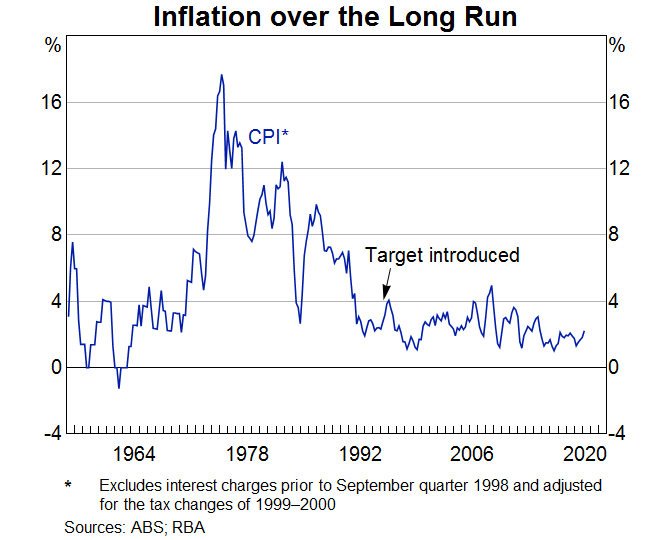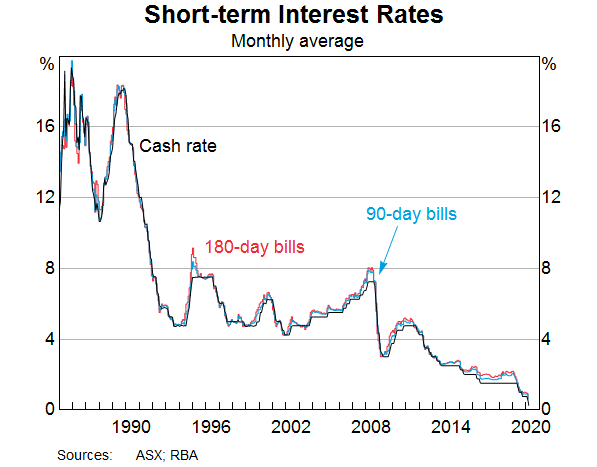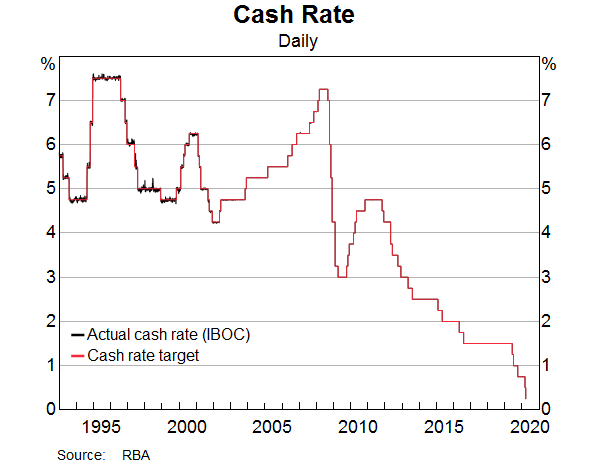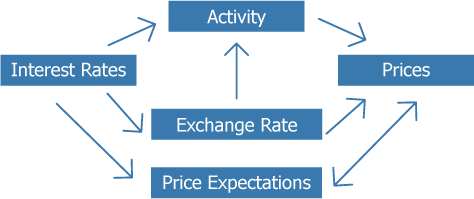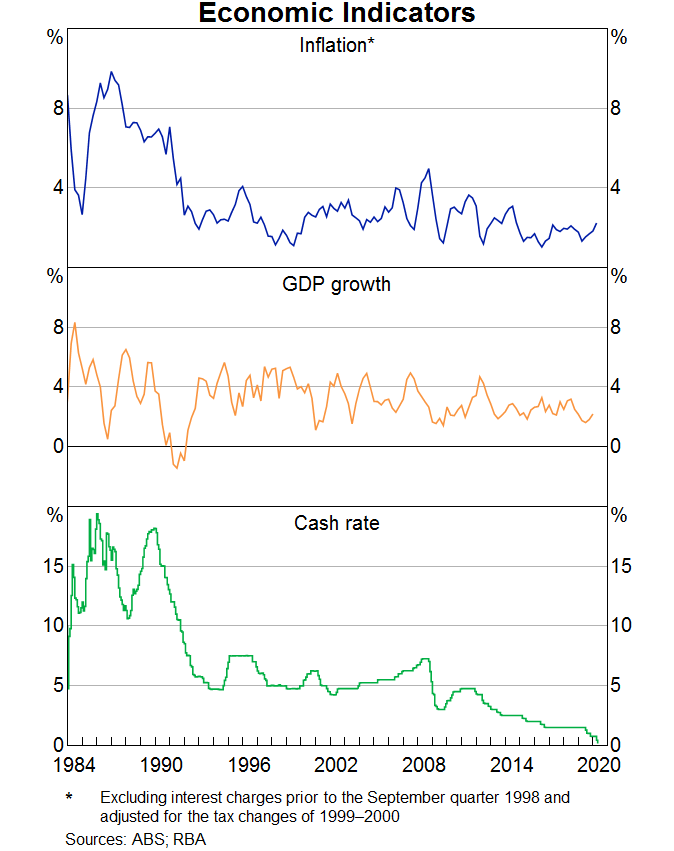Defined Terms and Documents
About Monetary Policy
What is Monetary Policy?
The Reserve Bank of Australia is responsible for formulating and implementing monetary policy. Monetary policy decisions involve setting the interest rate on overnight loans in the money market. Other interest rates in the economy are influenced by this interest rate to varying degrees, so that the behaviour of borrowers and lenders in the financial markets is affected by monetary policy (though not only by monetary policy).
What are the Objectives of Monetary Policy?
The Reserve Bank Board sets interest rates so as to achieve the objectives set out in theReserve Bank Act 1959
- the stability of the currency of Australia;
- the maintenance of full employment in Australia; and
- the economic prosperity and welfare of the people of Australia.
Since the early 1990s, these objectives have found practical expression in a target for consumer price inflation, of 2–3 per cent per annum. Monetary policy aims to achieve this over the medium term so as to encourage strong and sustainable growth in the economy. Controlling inflation preserves the value of money. In the long run, this is the principal way in which monetary policy can help to form a sound basis for long-term growth in the economy.
The Monetary Policy Framework
The principal medium-term objective of monetary policy is to control inflation, so an inflation target is thus the centrepiece of the monetary policy framework. The Governor and the Treasurer have agreed that the appropriate target for monetary policy is to achieve an inflation rate of 2–3 per cent, on average, over the cycle.[1] This is a rate of inflation sufficiently low that it does not materially distort economic decisions in the community. Seeking to achieve this rate, on average, provides discipline for monetary policy decision-making, and serves as an anchor for private sector inflation expectations.
The inflation target is defined as a medium-term average rather than as a rate (or band of rates) that must be held at all times. This formulation allows for the inevitable uncertainties that are involved in forecasting, and lags in the effects of monetary policy on the economy. Experience in Australia and elsewhere has shown that inflation is difficult to fine-tune within a narrow band. The inflation target is also, necessarily, forward-looking. This approach allows a role for monetary policy in dampening the fluctuations in output over the course of the business cycle. When aggregate demand in the economy is weak, for example, inflationary pressures are likely to be diminishing and monetary policy can be eased, which will give a short-term stimulus to economic activity.
This approach to monetary policy in Australia commenced in the early 1990s. The earliest references to it were contained in speeches by the then Governor in August 1992 and March and August 1993.
The Monetary Policy Decision Process
The formulation of monetary policy is the primary responsibility of the Reserve Bank Board. The Board usually meets eleven times each year, on the first Tuesday of the month except in January. Hence, the dates of meetings are well known in advance. For each meeting, the Bank's staff prepare a detailed account of developments in the Australian and international economies, and in domestic and international financial markets. The papers contain a recommendation for the policy decision. Senior staff attend the meeting and give presentations. Monetary policy decisions by the Reserve Bank Board are communicated publicly shortly after the conclusion of the meeting.
The Implementation of Monetary Policy
From day to day, the Bank's Domestic Markets Department has the task of maintaining conditions in the money market so as to keep the cash rate at or near an operating target decided by the Board. The cash rate is the rate charged on overnight loans between financial intermediaries. It has a powerful influence on other interest rates and forms the base on which the structure of interest rates in the economy is built. The close relationship between the cash rate and other money market interest rates can be seen in Graph 2. Changes in monetary policy mean a change in the operating target for the cash rate, and hence a shift in the interest rate structure prevailing in the financial system.
The Reserve Bank Board's explanations of its monetary policy decisions are announced in a media release, which is distributed through electronic news services and published on the Reserve Bank's website at 2.30 pm on the day of each Board meeting. Any change to the cash rate target will take effect from the following day.
The Reserve Bank uses its domestic market operations (sometimes called ‘open market operations’) to keep the cash rate as close as possible to the target set by the Board, by managing the supply of funds available to banks in the money market.
The cash rate is determined in the money market as a result of the interaction of demand for and supply of overnight funds. The Reserve Bank's ability to pursue successfully a target for the cash rate stems from its control over the supply of funds which banks use to settle transactions among themselves. These are called exchange settlement funds, after the accounts at the Reserve Bank in which banks hold these funds.
If the Reserve Bank supplies more exchange settlement funds than the commercial banks wish to hold, the banks will try to shed funds by lending more in the cash market, resulting in a tendency for the cash rate to fall. Conversely, if the Reserve Bank supplies less than banks wish to hold, they will respond by trying to borrow more in the cash market to build up their holdings of exchange settlement funds; in the process, they will bid up the cash rate. The actual level of the cash rate, which results from the Reserve Bank's market operations, as well as the target rate are shown in Graph 3.
The Transmission of Monetary Policy to the Economy
Movements in the cash rate are quickly passed through to other capital market interest rates such as money market rates and bond yields. These interest rates are also influenced by the risk tolerance of investors and preferences for holding funds in a form that are readily redeemable. The cash rate and other capital market interest rates then feed through to the whole structure of deposit and lending rates. In Australia, most deposits and loans are at variable or short-term fixed rates, so there is a high pass through of changes in the cash rate to deposit and lending rates. But because of the other factors influencing capital market rates, and fluctuations in the level of competition in the banking sector, deposit and lending rates do not always move in lockstep with the cash rate.
The changes in interest rates affect economic activity and inflation with much longer lags, because it takes time for individuals and businesses to adjust their behaviour. Interest rates affect economic activity via a number of mechanisms (Graph 4). They can affect saving and spending behaviour of firms and households, as well as cash flow, the supply of credit, asset prices and the exchange rate, all of which affect the level of aggregate demand. In turn, developments in aggregate demand, in conjunction with developments in aggregate supply, influence the level of inflation in the economy. Inflation is also influenced by the effect that changes in interest rates have on imported goods prices, via the exchange rate, and through their effect on inflation expectations more generally in the economy.
The ways in which monetary policy affects the economy are far from mechanical in their operation. In aggregate, however, a general negative association between interest rates and both demand growth and inflation is clear (Graph 5). Substantial rises in interest rates, designed to restrain inflationary booms, have been followed by contractions in demand and a reduction in inflation. Conversely, substantial interest rate reductions have been followed by periods of significantly faster growth. In responding to cyclical developments and inflationary pressures, monetary policy has had a powerful influence on aggregate demand and inflation in the economy.
The Relationship Between Monetary Policy and Debt Management
Sound financial policy requires that the Government fully fund any budget deficit by issues of securities to the private sector at market interest rates, and not borrow from the central bank. Many countries have legislation to deliver this outcome, though in Australia it is effectively achieved by agreement between the Treasury and the Reserve Bank. This arrangement means that there is separation between monetary policy and the Government's debt management, with the Treasury directly responsible for the latter and the Reserve Bank responsible for the former. The Bank subscribes to tenders when necessary for its own portfolio management purposes and provides registry services, but since October 2006 the Bank no longer acts as agent for the Australian Government in conducting tenders of Australian Government Securities.
It is not possible to ensure that the Australian Government's need for funds are exactly matched day-by-day by issues of securities to the market. For one thing, issues generally occur only weekly. To overcome this mismatch between daily spending and financing, the Treasury keeps cash balances with the Reserve Bank that act as a buffer. The Reserve Bank also provides an overdraft facility for the Government that is used to cover periods when an unexpectedly large mismatch exhausts cash balances. The agreement between the Treasury and the Reserve Bank places strict controls on access to the overdraft facility, as well as imposing a market-related interest rate on the facility. The overdraft is used infrequently, generally to cover unforeseen shortfalls in cash balances, and is extinguished at the next Treasury Note tender.
The Relationship Between the Bank and the Government
The Reserve Bank Board makes decisions about interest rates independently of the political process – that is, it does not accept instruction from the Government of the day on interest rates. This principle of central bank independence in the operation of monetary policy, in pursuit of accepted goals, is the international norm. It prevents manipulation of interest rates for political ends, and keeps monetary policy focused on its long-term goals.
With this independence naturally comes a need for consultation and accountability. The relationship of the RBA with the Government is one of independence with consultation, as outlined in Consultation with Government and Accountability to Parliament.
Accountability for Monetary Policy
The Reserve Bank's conduct of monetary policy is explained publicly through several channels. The Bank makes a public announcement of any policy decision, giving detailed reasoning for it. Minutes of the monetary policy meetings of the Reserve Bank Board are published two weeks after each meeting. It publishes four Statements on Monetary Policy each year, which contain a detailed analysis of the economy and financial markets, and an account of the considerations for the policy stance adopted by the Bank. The Governor appears twice each year before the House of Representatives Standing Committee on Economics, to answer questions on the Bank's conduct of policy.
Footnote
